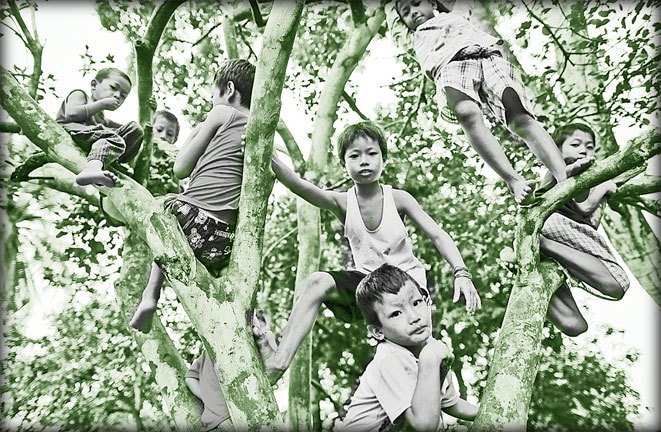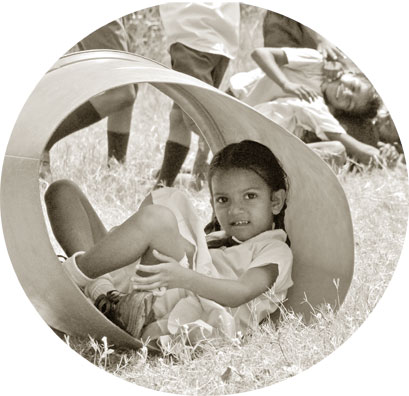Are children victims of a violent culture?
by Carol Aloysius
 Children's Day exploded amid the thunderous sound of bombs, gun fire
and violence, as millions of children woke up for perhaps the last day
of their young lives in the war torn Middle East. As they battled vainly
against hunger, thirst, and inclement weather the fiery speeches of
activists and self image pushing politicians fell on this most
vulnerable segment of society like shifting sand in the blowing winds
across the desert. Children's Day exploded amid the thunderous sound of bombs, gun fire
and violence, as millions of children woke up for perhaps the last day
of their young lives in the war torn Middle East. As they battled vainly
against hunger, thirst, and inclement weather the fiery speeches of
activists and self image pushing politicians fell on this most
vulnerable segment of society like shifting sand in the blowing winds
across the desert.
For many, no matter where they lived, especially, those trapped by
poverty , ignorance , and growing up in violent environments where
sexual abuse, rape, drug abuse, kidnappings and even murder were no
longer confined to the murky depths of the underground world, the
celebrations of another Children's Day had no significance.
It was simply another day of rough , tough living , of having to beg
on the street for food, peddle drugs in return for a few coins from drug
hawkers who employed them , or sell their bodies to men who found joy in
underaged sex.
Children's Day , in the war torn nations of the Middle East, saw
thousands of children displaced from their familiar environments
shattered by bombs, as television screens flashed tear jerking images of
toddlers stretching out empty plates while a long line of men and women
stood in queues for the meagre provisions brought to them by various non
governmental organisations including the Red Cross. Clad only in the
clothes they wore while fleeing from their shattered homes, their flimsy
makeshift shelters are anything but a shield to protect their tender
bodies from scorching heat at day, and icy temperatures at night. The
estimated number of children living in these camps is said to be nearly
three million. Deprived of their basic rights, such as, food, water,
clothes, shelter and education, it is likely that unless the war that
rages around them ceases, the chances for survival reduces every day,
every hour a bomb drops.
For most children growing up amid the violence and breakdown of human
values , and caught up in the dizzying speed of life where the fine line
between the real and the unreal world into which they want to escape
with hard drugs, time is a proverbial trap. It means everything and
nothing. Take the case of the millions of children engaged in manual
backbreaking labour . For children in the carpet making industry which
reportedly hires children as young as five years to weave their
exquisite products now found in almost every international up market,
time means nothing, as the day drags on into night with only a few hours
of sleep before their next day's labour begins.
Laws
Despite laws, sanctions and the International Labour Organisation (
ILO) insisting that all children attend school till the age of 14, child
labour continues to engulf the world. The Indian National Census
reportedly estimated an average of 12.5 million children between the
ages of 5 and 14 to be engaged in labour in the informal sector.
While there is no such national survey in our country, the fact
remains that in certain areas where gem mining and stone cutting are
traditional occupations , there is strong evidence that young children
are still being used to break stones and cut gems for a paltry take home
pay.
Hi-tech jobs
It is not just the informal sector that is caught up in this speed
trap. For professionally qualified young people in hi tech jobs, hunched
before computer machines in banks, hotels, industries, time is the only
thing that matters. Their maxim; The faster you deliver, the better your
chances of surviving the rat race. This affects young professionals in
Sri Lanka as well where there is now an increasing computer literate
public , with some 47 percent of young persons ( children ,) said to be
computer literate. While the sky is the limit if they deliver in time,
there are dangers of over using this facility, research has now
revealed. According to them, chances are these young persons could end
up brain fagged, burned out or become addicted to the extent they have
no time for sports or extracurricular activities.
Computer literacy rate at present in Sri lanka is 39.2%. Age-wise the
highest computer literate is in the f age group 15-19 years( 58%)
English language computer literate rate is the highest in the country at
69.5%.
|

Pic: Susantha Wijegunasekara |
In the case of growing children the negative health impacts are more
complex , with more children ending up overweight or obese and becoming
early victims of non communicable diseases that normally affect older
persons, such as, diabetes and cardiac diseases. The current trend of
obesity among primary schoolchildren especially has zoomed to such an
extent that it has prompted concerned local health officials to warn
parents and teachers to insist that children take part in more sports
and regulate their time spent on sedentary activities including
accessing the internet, or watching television..
Violent culture
Growing up amid violence , broken homes , and communication problems
with their parents , children today have also become the victims of a
violent culture.
Sri Lanka is no exception
The loss of extended families, the tendency for smaller family units
and single family housing , along with internal migration from villages
to towns and cities has negatively impacted on the Sri Lankan child.
With no grandparent or aunt to look after them in the absence of their
working parents , many children are now spending more time alone in the
house with the television as their babysitter. Others are deposited at a
nearby day care centre till the arrival of their parents, at late
evening, exposing them to institutional sexual abuse , which, judging by
recent news reports, is clearly on a roll.
Little wonder that these 'latch key children' to coin a phrase from
the west where it is a common trend, soon become addicted to the
violence they watch on the screen , some trying to imitate super heroes
by jumping off balconies , while others charged by the violence they
have witnessed, simply take out their frustrations on their peers during
a cricket match such as, what happened a few days ago . Breakdown of
communications between parent and child has further spiked the inner
demons of uncertainty and fears that are part of the growing up process.
Take the issue of Reproductive Health , a subject assiduously avoided by
both teachers and parents if forced into the open. With no response from
the adults most children who are still ignorant of basic facts about sex
according to surveys by the Sri Lanka Family Planning Association , turn
to peer counselling . The result is, wrong information which could be
both misleading and dangerous, says a spokesperson for the Association.
In this respect the recent suggestion by the Health Ministry special
task force to introduce Reproductive Health as a subject in the
curriculum vitae for more senior schoolchildren is welcome.
Future
The hotline for children set up by the National Child Protection
Authority has been reported to have received several calls since its
inception in .... , the most number being allegedly reported in the
Nuwara Eliya district..
The good news is that this service which now works day and night and
where officers trained in child psychology man the network of different
child friendly police stations set up islandwide, is to be expanded to
meet the growing demand.
But many questions remain to be properly wrinkled out.
Question 1-Once the entry has been made by a child who has been
sexually abused, what guarantee is there that the accused will not
retaliate and wreck vengeance on the child or her family members, as has
happened in recent cases.?
Question 2- If the child has to remain in police custody if there is
no one to take her home, where will he/ she be kept? Behind bars? Inside
a room full of hardened criminals?
Question 3- How will the child be transported to the prison cell? In
a prison van where he/she can be identified by a friend and thereafter
be judged even though innocent?
Question 4.- what happens to pregnant girl children ? Can they keep
their babies and still lead normal lives? According to reports girls as
young as 11 have given birth out of wedlock. Will they be able to go
back to school? Will their schools be ready to accept them? Or reject
them as being a' bad influence ' on the rest of the children?
Conclusion
Whatever way you look at the complex problems that children in our
modern society face the one thing that is clear is that there is no
simple solution. To remove the prejudice, stigma, apathy , and
complacency that underline practically all these problems including the
little researched mental and psychological problems that impact them ,
calls for collective action by all stakeholders - including
representatives from youth parliaments and other child organisations.
Only then will the dream of every child for a better world, a cleaner
world , a world without violence and prejudice become a reality. |

